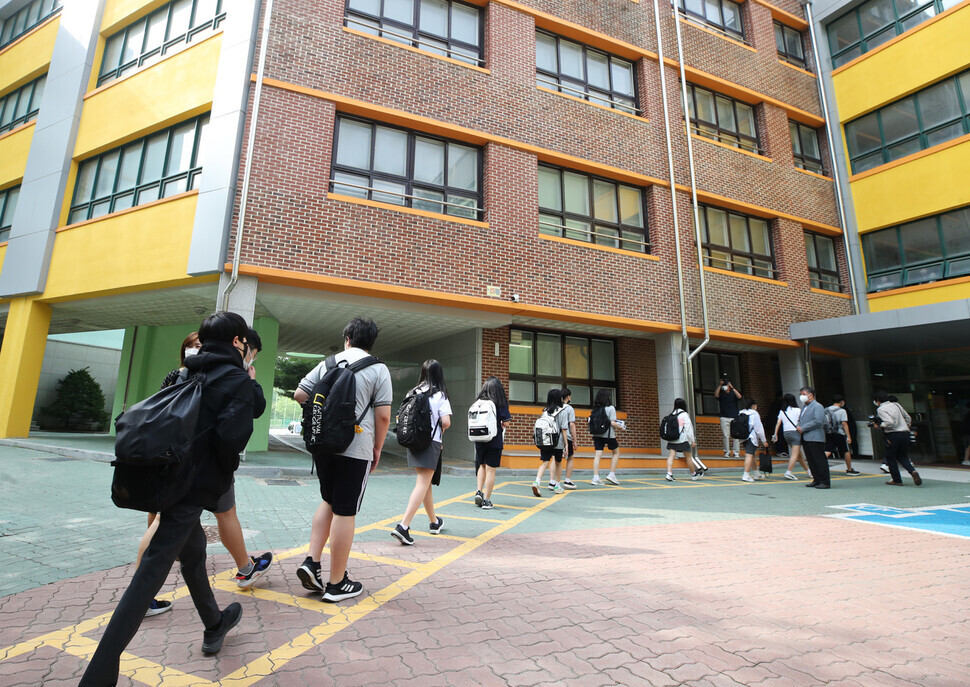hankyoreh
Links to other country sites 다른 나라 사이트 링크
Schools will reopen for second semester if daily COVID-19 cases remain under 1,000

South Korean kindergartens and elementary, middle, and high schools will be allowed to fully return to in-person classes as of the second semester, as long as the average daily number of confirmed COVID-19 cases remains lower than 1,000 per week.
While this signals a full-scale return to “normality” in schools, observers have criticized the associated enhanced disease prevention measures as a “rehash” of past ones.
On Sunday, Deputy Prime Minister and Minister of Education Yoo Eun-hae announced a “phased implementation plan for full-scale in-person classes in the second semester,” including new standards for the number of people permitted at schools that are linked to the revised social distancing measures that go into effect on July 1.
Like the social distancing measures, the implementation plan also revises the guidelines for allowable numbers of people at schools from five levels to four.
As a rule, all students are to report to school for classes at Level 1, when the average daily number of new confirmed cases nationally is below 500, and Level 2, when it is between 500 and 999.
While full-scale attendance is to be the rule as much as possible at Level 2, the possibility of three-quarters attendance for the third to sixth grades of elementary schools and two-thirds attendance for middle and high schools has also been left open, depending on the local conditions.
In cases of particularly large schools and crowded classes, allowable attendance can be adjusted based on a process of gathering feedback from those working or studying there.
The current Level 3 distancing guidelines require all classes to be conducted remotely. At the new Level 3 measures (1,000-1,999 new cases per day), students will be able to attend in-person classes as long as they comply with the guidelines for three-quarters attendance for the third to sixth grades of elementary school, one-third to two-thirds attendance for middle school, and two-thirds attendance for high school.
Daily attendance is to be allowed through Level 3 for kindergartens and the first two years of elementary school, while full-scale attendance is to be allowed for small schools, special schools (classes) and vocational high schools.
At Level 4 (2,000+ confirmed cases per day), all classes are to take place remotely.
While the revised social distancing measures are to go into effect on July 1, the Ministry of Education (MOE) plans to apply the new attendance guidelines from the start of the second semester in early September. Even after the semester begins, it plans to institute a two-week adjustment period in consideration of the disease control preparation situation and local infection conditions.
The MOE also announced supplementary measures Sunday for disease prevention systems within schools. Based on an initial demand survey, the ministry plans to send 49,942 disease control workers into schools during the second semester.
The number is around 1,200 higher than the 48,666 workers dispatched during the first semester (as of May 1). The MOE announced plans to provide 10,000 additional workers following a second demand survey.
While this would take the number of disease control workers at schools to as high as 60,000, many on the ground are suggesting that even that is not enough.
“Mathematically, the transition from two-thirds attendance to full-scale attendance should require an increase [in disease control workers] of around 34%. Even if they provide as many as 60,000, that’s still only a 20% increase from the first semester,” said Han Sang-yoon, chairperson of the Korean Association of Elementary, Middle, and High School Principals and the principal of Bongeun Elementary School in Seoul, in a telephone interview Sunday with the Hankyoreh.
“We would need two to three more workers just to transition from a two-group to a three-group system in terms of school meals,” Han said.
By Lee You-jin, staff reporter
Please direct comments or questions to [english@hani.co.kr]

Editorial・opinion
![[Editorial] Penalties for airing allegations against Korea’s first lady endanger free press [Editorial] Penalties for airing allegations against Korea’s first lady endanger free press](https://flexible.img.hani.co.kr/flexible/normal/500/300/imgdb/original/2024/0502/1817146398095106.jpg) [Editorial] Penalties for airing allegations against Korea’s first lady endanger free press
[Editorial] Penalties for airing allegations against Korea’s first lady endanger free press![[Editorial] Yoon must halt procurement of SM-3 interceptor missiles [Editorial] Yoon must halt procurement of SM-3 interceptor missiles](https://flexible.img.hani.co.kr/flexible/normal/500/300/imgdb/child/2024/0501/17145495551605_1717145495195344.jpg) [Editorial] Yoon must halt procurement of SM-3 interceptor missiles
[Editorial] Yoon must halt procurement of SM-3 interceptor missiles- [Guest essay] Maybe Korea’s rapid population decline is an opportunity, not a crisis
- [Column] Can Yoon steer diplomacy with Russia, China back on track?
- [Column] Season 2 of special prosecutor probe may be coming to Korea soon
- [Column] Park Geun-hye déjà vu in Yoon Suk-yeol
- [Editorial] New weight of N. Korea’s nuclear threats makes dialogue all the more urgent
- [Guest essay] The real reason Korea’s new right wants to dub Rhee a founding father
- [Column] ‘Choson’: Is it time we start referring to N. Korea in its own terms?
- [Editorial] Japan’s rewriting of history with Korea has gone too far
Most viewed articles
- 160% of young Koreans see no need to have kids after marriage
- 2Months and months of overdue wages are pushing migrant workers in Korea into debt
- 3[Editorial] Penalties for airing allegations against Korea’s first lady endanger free press
- 4[Guest essay] Maybe Korea’s rapid population decline is an opportunity, not a crisis
- 51 in 3 S. Korean security experts support nuclear armament, CSIS finds
- 6[Reporter’s notebook] In Min’s world, she’s the artist — and NewJeans is her art
- 7Bills for Itaewon crush inquiry, special counsel probe into Marine’s death pass National Assembly
- 8S. Korea discusses participation in defense development with AUKUS alliance
- 9Japan’s standards for use of preemptive counterstrike against N. Korea remain unclear
- 10Trump asks why US would defend Korea, hints at hiking Seoul’s defense cost burden